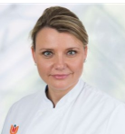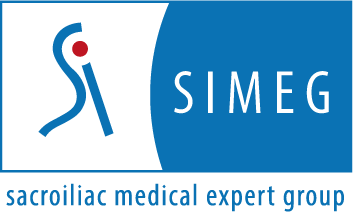Q & A
Answers from Dr. Kurosawa
Q: Fuchs - Can you explain the SIJ shear test?
With the patient in the supine position, slowly apply pressure to the sacroiliac joint with the palms of both hands just above the PSIS on each side.
We check whether this procedure reproduces the pain.
This is the same as the Bernard’s technique.
Why is the tenderness of the sacrotuberous ligament so important?
The sacrotuberous ligament is important in two aspects. Biomechanically, when the sacrum remains in a state of over Nutation, the sacrotuberous ligament will continue to be strained. This cause stress on at the ischial tuberosity attachment site of the sacrotuberous ligament. So, we believe that increased tenderness of the sacrotuberous ligament is associated with chronic SIJ dysfunction. Also, the origin of the biceps femoris is the ischial tuberosity, and it connect to the sacrtouberous ligament with the fascial tissue. This was well understood when I dissected the area myself. In other words, tight hamstrings are more likely to cause hyperextension of the sacrtuberous ligament and result in secondary to SIJ dysfunction. It is important for the physical therapist to stretch the hamstrings to prevent recurrence.
Why didn´t you include the “sacral thrust test” in your bundle of provocation tests?
The sacral thrust test is the one that applies pressure to the center of the sacrum. On the other hand, the SIJ shear test is that which applies pressure just above the sacroiliac joints on both sides. I prefer the SIJ shear test because it allows comparison of the degree of pain reproduction on the left and right side.
Why have you decided for a cut-off point of more than 70% after a SIJ injection?
Although not scientifically proven, 50% means that there is another source of pain in addition to the SIJ pain, making it difficult to determine that the SIJ is the primary cause of the condition.
If it is less than 3 on the Numerical Rating Scale (NRS), it is "mild pain". We use the Pain Relief Scale to determine the effectiveness of the injections. If the pre-injection pain is assumed to be 10 and the remaining pain after the injection is 3 or less, we consider the pain to be 70% relieved. If a patient says that the remaining pain after the injection is less than 3, we can judge that the pain is not so severe and that the injection was effective.
If we use the VAS to calculate the rate of pain reduction by comparing the pre-injection and post-injection values, it is difficult to achieve 70% or 80% pain reduction in patients with low pre-injection VAS, even if the pain is actually quite reduced.
VAS is not useful when we use it to judge the efficacy of the injection because the intensity of pain before injection is different in each patient.
Do you think that joint stiffness can be increased by training the abdominal muscles? Because if the ligaments in the back of the SIJ are worn out why should an increased strength of the abdominal muscles compensate this?
I don't know the true mechanism yet. However, if a patient can keep the abdominal muscles well during active SLRT, the pain in the SIJ region is reduced.
When patients can use the abdominal muscles well in the daily life, SIJ is less likely to be triggered during daily activities. Many patients have experienced pain reduction with SIJ injections but recurrence of pain when returning to work activities, but by strengthening the abdominal muscles, some patients do not need injections after about two months. Instead of a pelvic belt, I can see that patients can stabilize the SIJ with their own abdominal muscles. This is an important topic that we would like to have sports physicians who see many SIJ pain in athlete give a lecture someday.
What kind of needle do you use for intraarticular injection of the SIJ?
I use 23 gauge needles with a length of 70mm.
Answers from Dr. van Wingerden

Question Fuchs: What is your strategy to achieve understanding and acceptance by the SIJ patients?
Good question. What we do is provide a concept to the patients (form and force closure) which allows them to comprehend why their body gives problems. From this concept they logically derive the steps they have to take for recovery. Sometimes patients cannot understand (low intelligence) but moreoften patients are reluctant to understand (because the consequence is that they have to take action to recover.
So a major part of therapy is to stimulate committment. Here the circle of information, action/exercise, positive experience (positive emotional stimulus) comes in handy. If patients experience they can positively influence their problem (less pain, more capacity) they are stimulated to take next steps.
In addition: in our program patients come in twice a week for 8 weeks (16 sessions) for 3 hours per session. Each session is one hour exercise/physical experience, one hour education and ons hour training again.
Daisuke Kurosawa:
Qestion to Jan-Paul: What is the biggest difference in rehabilitation and exercise therapy methods between cases with pelvic problems involving the sacroiliac joints and those with mainly lumbar spine problems? Or are they the same?
Interesting question! Basically there is not much difference, because in both patient groups we try to recover trunk function (including pelvis and spine). What we see is that pelvic pain patients (PGP) have a slower recovery rate. We assume this is because the pelvis is actually load bearing (more than the spine), and more easily overloaded. Therefore the process is more graduate in PGP patients.
How do you adjust the State of mind, say Meditation?
Yes indeed, mindfulness exercises can help. What we do a lot is (physical) relaxation exercises, but we also suggest the body scan of Kabat-Zinn which technique is derived from eastern meditation techniques.
Qestion to Jan-Paul: Have your institution's methods spread to other institutions in the Netherlands and Europe?
Bengt Sturesson has set up a similar organisation in Sweden, but we have not been in contact for many years, so i don’t know how their therapy developed.
We give many courses in the Netherland and some abroad. The biggest challenge for many therapists is that we apply a very different approach to understandig function. This may seem weird because you might think functioon is just function. But the integrative way we look at function of low back and pelvis is for many therapist rather new, and hard to implement in their daily practice. Many tend to look at facet joints, discs, muscles and/or fascia more or less in isolation. But we try to comprehend the system as a whole. A new development in this appoach is that we no longer look at muscle function only, but try to stimulate the body as a whole. We consider the trunk as a pressure system, in which all structures cooperate in this function. This might be a subject for a next presentation!
If not, what are the bottlenecks? Is it still difficult to reproduce the methods that you have accumulated over the years?
Like I said, it is! For ‘stand alone‘ therapists it is hard to keep the perspective we learn them.
I would not say the method in itself is difficult. The difficulty is in keeping the format straight and not be seduced to doing other things. This can differ be between making it psychological or wanting to do manipulations.
Maybe I make it sound like a dogma, but that is not what we want it to be. The application of (therapeutical) techniques should be based on logic and strict analysis and understanding of a problem. Not on what the therapist fancies.
Question to Jan-Paul: Do you suggest cooling or steroid injections into the intraarticular for cases with strong Inflammation from your institution?
Interesting question also. There is an issue we have not discussed yesterday: If patients are in pain, we want to take away their pain. But pain is also a very good behavioral stimulus. If we have a patient in pain and suggest to take resting moments, the patient will be keen on trying this because he or she may have a chance on influencing his or her problem.
If we at the same time do an injection which diminishes the pain we actually give the patient the message: you have to do nothing, the injection will help to diminish your pain. Consquently from a behavioral point of view this may not be very effective in the long run.
On the other hand sometimes a patient is in so much pain that no exercise can be performed. Then we have the dilemma whether to give or not to give an injection! Sometimes the injections helps to make the patient ‘trainable‘. So then we suggest taking an injection or medication.
Answers from Dr. Karolina Szadek

Q: What is your strategy to achieve understanding and acceptance by the SIJ patients?
#1. A physical therapist will be helpful to prolong the effectiveness of your pain relief therapy using with guidance of activities of daily living and training of the abdominal trunk muscles. I would like to hear about the current status of working with physical therapists.
A:
In the Netherlands minimal invasive treatments as well the physiotherapy for SI joint pain are not reimbursed. What we advise is the set of exercises to do at home.
On Bonaire we have a back school. Patients with low back pain can join the school and follow is in their own language (Dutch, English, Spanish or Papiamento).
Q: #2. Is there any possibility of the sacral multifidus muscles or gluteus muscle weakness after burning the branches of the innervating nerves to the SIJ?
For the multifidus the only case I can think of is the posterior ramus of the 5th lumbar nerve lesion, but I have never came across this complication. Neither the case of gluteus minimus and medius (superior gluteal nerve), gluteus maximus (inferior gluteal nerve). We stay away from these nerves. I can imagine you can do some damage if you do not use any imaging guidance and/or stimulation.
Q: #3. I often see SIJ combined with lumbar spine disease. Have you had any cases of L5-S herniation or LSTV that you had trouble diagnosing? Do your spine surgeon colleagues often refer to you for lumbar fusion sacroiliac pain?
What I see is the SIJ pain after the lumbo-sacral fusion, hip replacement, trauma, etc. Yes, it can be quite challenging to put the final diagnosis. I Holland I contact the neurologist or the orthopedic surgeon. Neurosurgeons refer patients to our clinic after the successful operation, whereby the pain remains. In Bonaire we see patients together and try to reach consensus.
There are a lot of changes going on in our center. I will keep you posted.
Q: #4. I understand that the last resort is radiofrequency neurotomy. In Japan, because of the concept of adhesion, i.e. pain caused by anchoring of nerve branches due to reduction of soft tissue water, there is a treatment named “Hydrorelease”, which uses saline solution to create more space around the nerve. PRP or prolotherapy is also used. Have these treatments become accepted in your country? I still don't know what kind of cases PRP is really good for. Maybe the condition of entesopathy. I don't know the difference between cases where it works and cases where it doesn't. It's expensive, so I can't try a lot of it.
I our clinic we do not have the possibility to use PRP. What we do sometimes is the phototherapy. In general there is a scarce evidence for these therapies.
